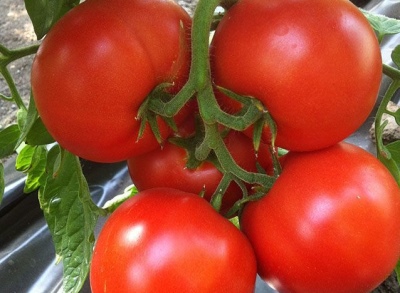
- Authors: ENZA ZADEN BEHEER B.V., Netherlands
- Year of approval: 2015
- Name synonyms: Agilis
- Category: hybrid
- Growth type: indeterminate
- Appointment: fresh consumption
- Ripening period: mid-season
- Ripening time, days: 90-95
- Growing conditions: for greenhouses
- Bush height, cm: up to 300
One of the advantages of the hybrid Agilis variety is the ability to grow it in different regions of the country, despite the climatic features. This species has taken root well in Russia due to its many positive characteristics. Now it is a favorite variety of some summer residents, including those who grow vegetables for sale.
Description of the variety
Mature bushes grow up to 300 centimeters. They reach this height only under favorable weather conditions. The plant is indeterminate, with short internodes. Leaves are of a standard green color, medium in length and covered with villi. The roots are strong, but located on the surface. Due to them, tomatoes grow quickly and absorb the right amount of moisture.
The first fruit clusters are formed above the 5-6 node. The rest will be located in 3 sheets. It is a mid-season variety that is designed for a short production cycle.
The main qualities of the fruit
Unripe tomatoes are colored green, which gradually fades into a rich red. The sizes of vegetables are large, the weight varies from 160 to 180 grams. The shape is round, slightly flat or medium-silvery. Under the peel, the pulp, medium in density, is hidden. Simple inflorescence. Each fruit is decorated with a rounded nose at the bottom.
Taste characteristics
Tomatoes are of high gastronomic quality. This is a salad variety, the fruits of which are eaten in their natural form.
Ripening and fruiting
The ripening period is 90-95 days. Ripening dates can be both medium and early, depending on the area of cultivation.
Yield
The yield of Agilis is noted as high. On one brush (their maximum number is 6 pieces) grows up to 6 tomatoes. Approximately 11.5 kilograms are harvested from one square meter of the site.
The timing of planting seedlings and planting in the ground
About 2 months (55-60 days) before the date of planting in the soil, the seeds are sown. As soon as a second full-fledged leaf appears on young shoots, you can start diving. This variety is usually grown in greenhouses and hotbeds. Despite the height of up to 3 meters, the bushes grow remarkably in small greenhouses.

Growing tomato seedlings is an extremely important process, because it largely depends on whether the gardener will be able to harvest at all. All aspects must be taken into account, from seedbed preparation to planting in the ground.
Landing scheme
When planting seedlings in a permanent growing place, up to 6 tomatoes are stirred in one square place of the territory. Tall stems need tying. This procedure will be performed immediately after the transplant. Bushes form into one stem. Stepping is performed periodically. Tomatoes are placed in rows.

Growing and care
Experienced gardeners recommend shaking the flowering brushes regularly. This has a positive effect on the formation of ovaries. Also, vegetables must be fed with organic or mineral compounds necessary for the formation of tasty and large fruits.
Tomatoes are looked after in the same way as other indeterminate varieties. The bushes are regularly watered, preventing the soil from drying out. Irrigation frequency depends on weather conditions. The work is carried out according to the established scheme. Weeds and plant residues are promptly removed on the site. In adverse weather conditions, preventive measures are taken to protect against infections and pests.




A plant needs different micronutrients at each stage of growth. All fertilizers can be divided into two groups: mineral and organic. Folk remedies are often used: iodine, yeast, bird droppings, eggshells.
It is important to observe the rate and period of feeding. This also applies to folk remedies and organic fertilizers.
Disease and pest resistance
This fruit crop variety is highly resistant to many common diseases and pests.
Tomato Agilis is not afraid:
- tobacco mosaic virus;
- fusarium wilting;
- cladosporiosis and other diseases.
Also, the fruits do not crack, retaining their shape and high commercial quality. Despite the strong immunity, it is advisable to regularly examine vegetables for symptoms and, if necessary, take preventive measures.


Resistant to adverse weather conditions
Tomato Agilis tolerates a short-term drop in temperature without any problems.
Review overview
On the Web, you can find many reviews from experienced gardeners who have been growing the above variety for several years.Growers from Rostov-on-Don, who have chosen Agilis for commercial purposes, speak positively about the variety. Ripe fruits with a bright color attract the attention of buyers. Even if the cultivation conditions are slightly violated, you can count on a high yield.
Summer residents from Voronezh also spoke positively about this fruit crop. Local gardeners say that they chose this variety in order to provide themselves and their families with fresh vegetables. To get a tasty and healthy harvest, you just need to build an ordinary greenhouse, plant seedlings and follow simple agricultural techniques. To save money, many summer residents buy seeds and grow seedlings on their own.
The disadvantages include the cost of planting material. Tomato Agilis is a hybrid variety, so you won't be able to get high-quality seed yourself.

























































































